Evaluation of Economic Linkage between Urban Built-Up Areas in a Mid-Sized City of Uyo (Nigeria)
Abstract
:1. Introduction
2. Study Area and Materials
2.1. Study Area
2.2. Data Source
3. Methods
3.1. Statistical Analyses
3.2. Object-Based Image Analysis
4. Results
4.1. Economic Growth in Uyo
4.2. Social Amenities in the Urban Area
4.3. Household Income
4.4. Urban Land Cover Change in Uyo
5. Discussion
Data Uncertainty
6. Conclusions
Author Contributions
Funding
Institutional Review Board Statement
Informed Consent Statement
Acknowledgments
Conflicts of Interest
References
- Mendonça, R.; Roebeling, P.; Martins, F.; Fidélis, T.; Teotónio, C.; Alves, H.; Rocha, J. Assessing economic instruments to steer urban residential sprawl, using a hedonic pricing simulation modelling approach. Land Use Policy 2020, 92, 104458. [Google Scholar] [CrossRef]
- Urban Sprawl in Europe (EEA)—Joint EEA-FOEN Report—European Environment Agency. 2016. Available online: https://www.eea.europa.eu/publications/urban-sprawl-in-europe (accessed on 15 April 2021).
- Pieterse, E. The Potential for Sustainable Urbanisation in Africa; Centre for Cities, University of Cape Town: Cape Town, South Africa, 2019. [Google Scholar]
- Xiangzheng, D.; Jikun, H.; Scott, R.; Emi, U. Economic Growth and the Expansion of Urban Land in China. Urban Stud. 2010, 47, 813–843. [Google Scholar] [CrossRef]
- Henderson, J. Handbook of Economic Growth; Brown University: Providence, RI, USA, 2005. [Google Scholar]
- Kalnay, E.; Cai, M. Impact of urbanization and land use on climate change. Nature 2003, 423, 528–531. [Google Scholar] [CrossRef] [PubMed]
- Vanum, G. Impact of urbanization and land-use changes on climate. Int. J. Phys. Social. Sci. 2012, 2, 414–432. [Google Scholar]
- Wei, D.; Ye, X. Urbanization land use and sustainable development in China. Stoch. Environ. Res. Risk Assess. 2014, 28, 755. [Google Scholar] [CrossRef] [Green Version]
- Shi, G.; Jiang, N.; Yao, L. Land Use and Cover Change during the Rapid Economic Growth Period from 1990 to 2010: A Case Study of Shanghai. Sustainability 2018, 10, 426. [Google Scholar] [CrossRef] [Green Version]
- Constanza, R.; d’Arge, R.; Groot, R.; Farber, S.; Grasso, M.; Hannon, B.; Limburg, K.; Naeem, S.; O’Neill, R.V.; Paruelo, J.; et al. The value of the world’s ecosystem services and natural capital. Nature 1997, 387, 253–260. [Google Scholar] [CrossRef]
- Couch, C.; Karecha, J. Controlling urban sprawl: Some experiences from Liverpool. Cities 2006, 23, 353–363. [Google Scholar] [CrossRef]
- Kulmer, V.; Furst, B.; Koland, O.; Kafer, A.; Steininger, K.W. The interaction of spatial planning and transport policy: A regional perspective on sprawl. J. Transp. Land Use 2014, 7, 57–77. [Google Scholar] [CrossRef] [Green Version]
- Poelmans, L.; Rompaey, A.V. Detecting and modelling spatial patterns of urban sprawl in highly fragmented areas: A case study in the Flanders-Brussels region. Landsc. Urban Plan. 2009, 93, 10–19. [Google Scholar] [CrossRef]
- Essien, E.; Samimi, C. Detection of Urban Development in Uyo (Nigeria) Using Remote Sensing. Land 2019, 8, 102. [Google Scholar] [CrossRef] [Green Version]
- Seto, C.; Kaufmann, K. Modeling the drivers of urban land-use change in the Pearl River Delta, China: Integrating remote sensing with socio-economic data. Land Econ. 2003, 79, 106–121. [Google Scholar] [CrossRef] [Green Version]
- Rindfuss, R.; Stern, P. Linking remote sensing and social science: The need and the challenges. In People and Pixels; National Academy Press: Washington, DC, USA, 1998. [Google Scholar]
- Taubenböck, H.; Esch, T.; Felbier, A.; Wiesner, M.; Roth, A.; Dech, S. Monitoring urbanization in mega cities from space. Remote Sens. Environ. 2012, 117, 162–176. [Google Scholar] [CrossRef]
- Sapena, M.; Ruiz, L.; Taubenböck, H. Analyzing Links between Spatio-Temporal Metrics of Built-Up Areas and Socio-economic Indicators on a Semi-Global Scale. ISPRS Int. J. Geo-Inf. 2020, 9, 436. [Google Scholar] [CrossRef]
- Felt, C.; Fragkias, M.; Larson, D.; Liao, H.; Lohse, K.; Lybecker, D. A comparative study of urban fragmentation patterns in small and mid-sized cities of Idaho. Urban Ecosyst. 2018, 21, 805–816. [Google Scholar] [CrossRef]
- Kyle, F. An Inquiry into the Nature and Causes of Nigeria’s Rapid Urban Transition. Urban Forum 2018, 29, 277–298. [Google Scholar]
- United Nations. World urbanization prospects ST/ESA/SER.A/366. In Department of Economic and Social Affairs; United Nations: New York, NY, USA, 2014. [Google Scholar]
- National Population Commission. International Migration Survey in Nigeria; National Population Commission: Abuja, Nigeria, 2014; Available online: https://publications.iom.int/system/files/pdf/mp_nigeria.pdf (accessed on 6 March 2020).
- Sean, F.; Robin, B.; Jose, M. Understanding the dynamics of Nigeria’s urban transition A refutation of the ‘stalled urbanization’ hypothesis. Urban Stud. 2018, 55, 947–964. [Google Scholar]
- Wu, J. Environmental amenities and the spatial pattern of urban sprawl. Am. J. Agric. Econ. 2001, 83, 691–697. [Google Scholar] [CrossRef]
- Brueckner, J.K.; Kim, H.-A. Urban Sprawl and the Property Tax. Int. Tax Public Finance 2003, 10, 5–23. [Google Scholar] [CrossRef]
- Peng, S.; Wang, P. A normative analysis of housing-related tax policy in a general equilibrium model of housing quality and prices. J. Public Econ. Theory 2009, 5, 667–696. [Google Scholar] [CrossRef]
- Ambarwati, L.; Verhaeghe, R.; Pel, A.J.; Van Arem, B. Controlling Urban Sprawl with Integrated Approach of Space-transport Development Strategies. Procedia-Soc. Behav. Sci. 2014, 138, 679–694. [Google Scholar] [CrossRef] [Green Version]
- Tscharaktschiew, S.; Hirte, G. Should subsidies to urban passanger transport be increased? A spatial CGE analysis for a German metropolitan area. Transp. Res. 2011, 46, 285–309. [Google Scholar]
- World Bank: Urban Regeneration /Master Planning. 2015. Available online: https://urban-regeneration.worldbank.org/node/51 (accessed on 23 January 2021).
- AKGS Online. Population of Akwa Ibom State. Available online: https://www.aksgonline.com/about_people_population.html (accessed on 5 May 2019).
- Wu, K.; Hao, Z. Land use dynamics, built-up land expansion patterns, and driving forces analysis of the fast-growing Hangzhou metropolitan area, eastern China (1978–2008). Appl. Geogr. 2012, 34, 137–145. [Google Scholar]
- Wu, K.Y.; Ye, X.Y.; Qi, Z.F.; Zhang, H. Impacts of land use/land cover change and socio-economic development on regional ecosystem services: The case of fast-growing Hangzhou metropolitan area, China. Cities 2013, 31, 276–284. [Google Scholar] [CrossRef]
- National Bureau of Statistics. 2020 Annual National Statistics Survey. Available online: https://www.nigerianstat.gov.ng/ (accessed on 27 January 2021).
- Tewes, A.; Thonfeld, F.; Schmidt, M.; Oomen, J.; Zhu, X.; Dubovyk, O.; Menz, G.; Schellberg, J. Using Rapid Eye and MODIS Data Fusion to Monitor Vegetation Dynamics in Semi-Arid Rangelands in South Africa. Remote. Sens. 2015, 7, 6510–6534. [Google Scholar] [CrossRef] [Green Version]
- Planet Team. Planet Application Program Interface. In Space for Life on Earth; Planet Team: San Francisco, CA, USA, 2017; Available online: https://api.planet.com (accessed on 22 June 2020).
- Feteme, A.; Hilker, T.; Yeshitela, K.; Prasse, R.; Cohen, W.; Yang, Z. Detecting Trends in Landuse and Landcover Change of Nech Sar National Park, Ethiopia. Environ. Manag. 2014, 57, 137–147. [Google Scholar] [CrossRef]
- Millard, K.; Richardson, M. On the importance of training data sample selection in random forest image classification: A case study in peatland ecosystem mapping. Remote Sens. 2015, 7, 8489–8515. [Google Scholar] [CrossRef] [Green Version]
- Sexton, J.; Urban, D.; Donohue, M.; Song, C. Long-term land cover dynamics by multi-temporal classification across the Landsat-5 record. Remote. Sens. Environ. 2013, 128, 246–258. [Google Scholar] [CrossRef]
- Hurskainena, P.; Adhikaria, H.; Siljandera, M.; Pellikkaa, P.; Hemp, A. Auxiliary datasets improve accuracy of object-based land use/land cover classification in heterogeneous savanna landscapes. Remote. Sens. Environ. 2019, 233, 111–354. [Google Scholar] [CrossRef]
- Merschdorf, H.; Hodgson, E.; Blaschke, T. Modeling Quality of Urban Life Using a Geospatial Approach. Urban Sci. 2020, 4, 5. [Google Scholar] [CrossRef] [Green Version]
- Zhang, Y.; Zhao, L.; Zhao, H.; Gao, X. Urban development trend analysis and spatial simulation based on time series remote sensing data: A case study of Jinan, China. PLoS ONE 2021, 16, e0257776. [Google Scholar] [CrossRef]
- Salvati, L.; Gargiulo, V.; Rontos, K.; Sabbi, A. Latent Exurban Development: City Expansion Along the Rural-To-Urban Gradient in Growing and Declining Regions of Southern Europe. Urban Geogr. 2013, 34, 376–394. [Google Scholar] [CrossRef]
- Ciommi, M.; Chelli, M.; Carlucci, M.; Salvati, L. Urban Growth and Demographic Dynamics in Southern Europe: Toward a New Statistical Approach to Regional Science. Sustainability 2018, 10, 2765. [Google Scholar] [CrossRef] [Green Version]
- Lichstein, W.; Simons, R.; Shriner, A.; Franzreb, E. Spatial autocorrelation and autoregressive models in ecology. Ecological. Monogr. 2002, 72, 445–463. [Google Scholar] [CrossRef]
- Blaschke, T.; Lang, S.; Tiede, D.; Papadakis, M.; Györi, A. Object-based image analysis beyond remote sensing the human perspective. Remote. Sens. Spat. Inf. Sci. 2016, 41, 879–882. [Google Scholar]
- Vieira, M.; Formaggio, A.; Rennó, C.; Atzberger, C.; Aguiar, D.; Mello, M. Object-Based Image Analysis and Data Mining applied to a remotely sensed Landsat time-series to map sugarcane over large areas. Remote. Sens. Environ. 2012, 123, 553–562. [Google Scholar] [CrossRef]
- Navulur, K. Multispectral Image Analysis Using the Object-Oriented Paradigm; Taylor & Francis Group 206: Boca Raton, FL, USA, 2007; ISBN 978-1-4200-4306-8. [Google Scholar]
- Gao, H. Research On Remote Sensing Geological Information Extraction Based On Object-Oriented Classification. ISPRS Ann. Photogramm. Remote. Sens. Spat. Inf. Sci. 2018, 4, 91–96. [Google Scholar] [CrossRef] [Green Version]
- Bhaskaran, S.; Paramananda, S.; Ramnarayan, M. Per-pixel and object-oriented classification methods for mapping urban features using Ikonos satellite data. Appl. Geogr. 2010, 30, 650–665. [Google Scholar] [CrossRef]
- Wang, W.; Li, W.; Zhang, C.; Zhang, W. Improving Object-Based Land Use/Cover Classification from Medium Resolution Imagery by Markov Chain Geo-Statistical Post Classification. Land 2018, 7, 31. [Google Scholar] [CrossRef] [Green Version]
- Myint, S.; Gober, P.; Brazel, A.; Grossman-Clarke, S.; Weng, Q. Per-pixel vs. object-based classification of urban land cover extraction using high spatial resolution imagery. Remote. Sens. Environ. 2011, 115, 1145–1161. [Google Scholar] [CrossRef]
- Definiens. Definiens Developer 7.0; User Guide; Definiens: München, Germany, 2008; p. 506. Available online: https://docplayer.net/5420998-Definiens-developer-7-user-guide-www-definiens-com.html (accessed on 27 January 2021).
- Egugbo, C.C. Resource Control and The Politics of Revenue Allocation in Nigerian Federation. AFRREV IJAH Int. J. Arts Humanit. 2016, 5, 186–201. [Google Scholar] [CrossRef] [Green Version]
- Ojo, A.; Ojewale, O. Urbanisation and Crime in Nigeria; Palgrave Macmillan: London, UK, 2019. [Google Scholar]
- Otubu, A. The Land Use Act and Land Administration in 21st Century Nigeria: Need for Reforms. J. Sustain. Dev. Law Policy 2018, 9, 80–108. [Google Scholar] [CrossRef]
- Milan, B.; Creutzig, F. Municipal policies accelerated urban sprawl and public debts in Spain. Land Use Policy 2016, 54, 103–115. [Google Scholar] [CrossRef] [Green Version]
- Cotteller, G.; Peerlings, J. Spatial planning procedures and property prices: The role of expectations. Landsc. Urban Plan. 2011, 100, 77–86. [Google Scholar] [CrossRef]
- Abrantes, P.; Fontes, I.; Gomes, E.; Rocha, J. Compliance of land cover changes with municipal land use planning: Evidence from the Lisbon metropolitan region (1990–2007). Land Use Policy 2016, 51, 120–134. [Google Scholar] [CrossRef]
- Milan, B.F.; Kapfer, D.; Creutzig, F. A systematic framework of location value taxes reveals dismal policy design in most European countries. Land Use Policy 2016, 51, 349. [Google Scholar]
- Ivan, T.; Gordon, M. Urbanization and economic growth: The arguments and evidence for Africa and Asia. Environ. Urban. 2013, 2, 25. [Google Scholar]
- Long, H.; Tang, G.; Li, X.; Heilig, G.K. Socio-economic driving forces of land-use change in Kunshan, the Yangtze River Delta economic area of China. J. Environ. Manag. 2007, 83, 351–364. [Google Scholar]
- Nse, O.U.; Okolie, C.J.; Nse, V.O. Dynamics of land cover, land surface temperature and NDVI in Uyo City, Nigeria. Sci. Afr. 2020, 10, e00599. [Google Scholar] [CrossRef]
- Akpan-Ebe, I.N.; Udotong, I.R.; Ekpenyong, R.E. Ecological Consequences of Urbanization of Uyo Capital City, Akwa Ibom State, Nigeria. J. Agric. Ecol. Res. Int. 2016, 7, 1–12. [Google Scholar] [CrossRef]
- Maxwell, A.E.; Warner, T.A.; Fang, F. Implementation of machine-learning classification in remote sensing: An applied review. Int. J. Remote Sens. 2018, 39, 2784–2817. [Google Scholar] [CrossRef] [Green Version]
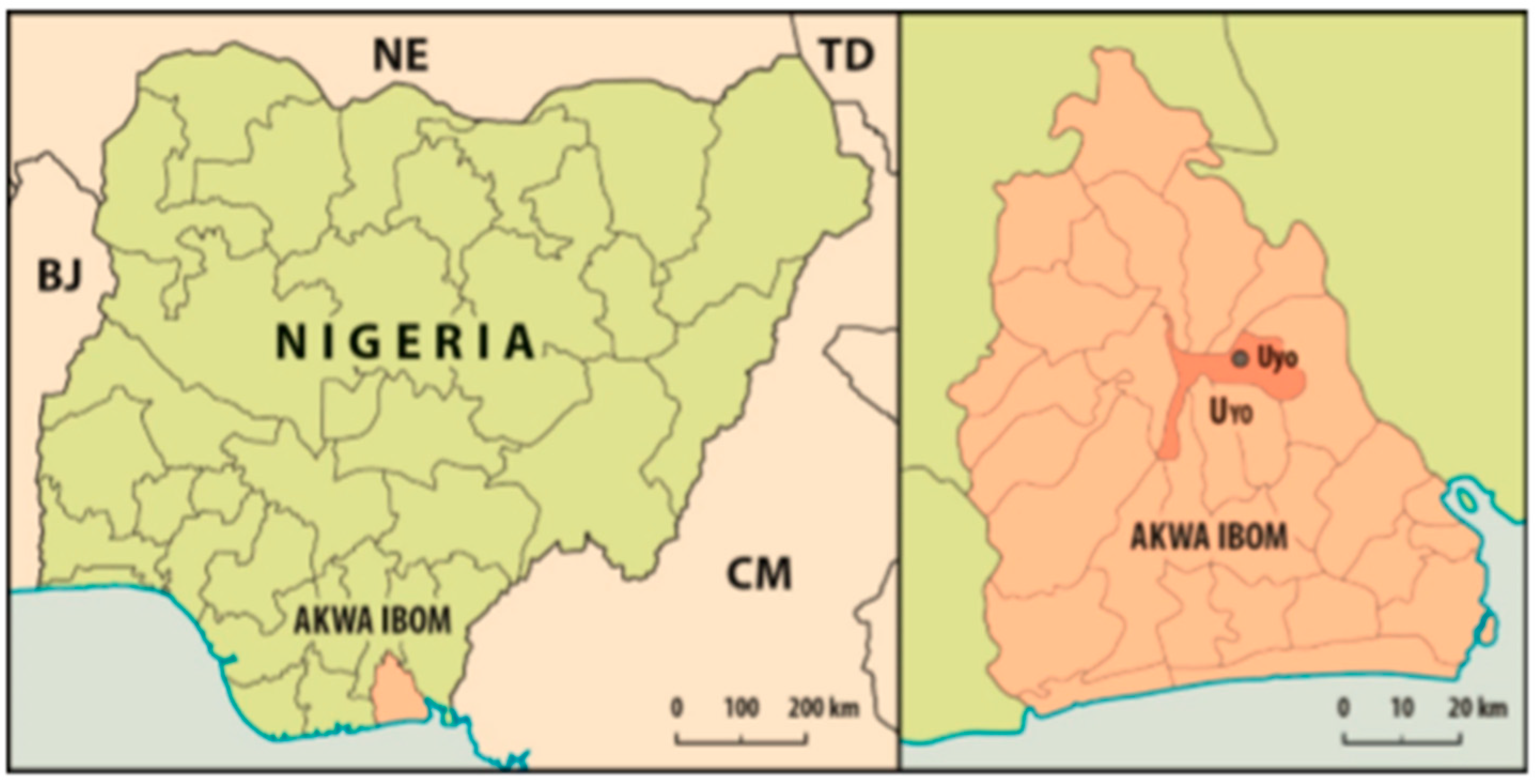
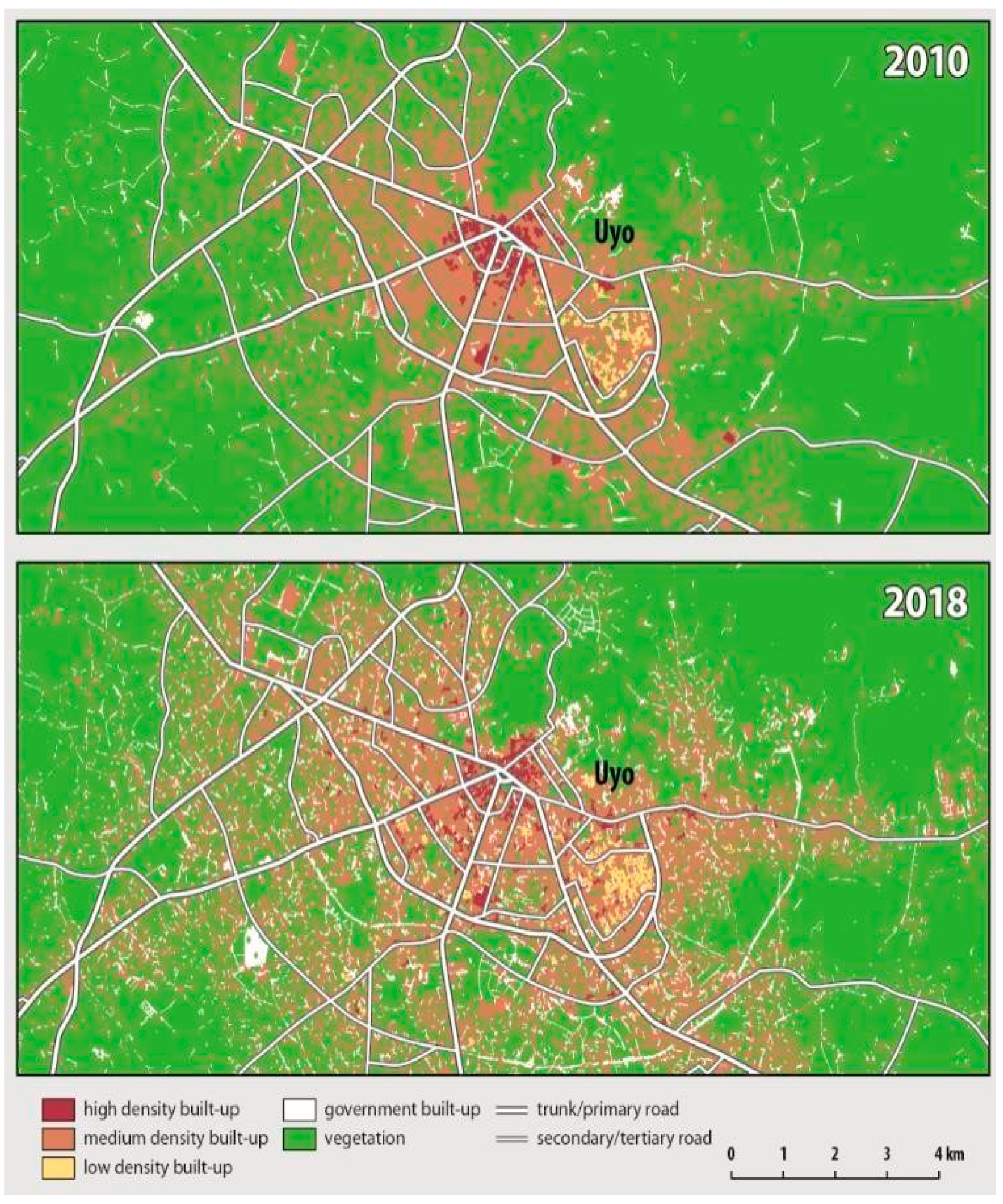

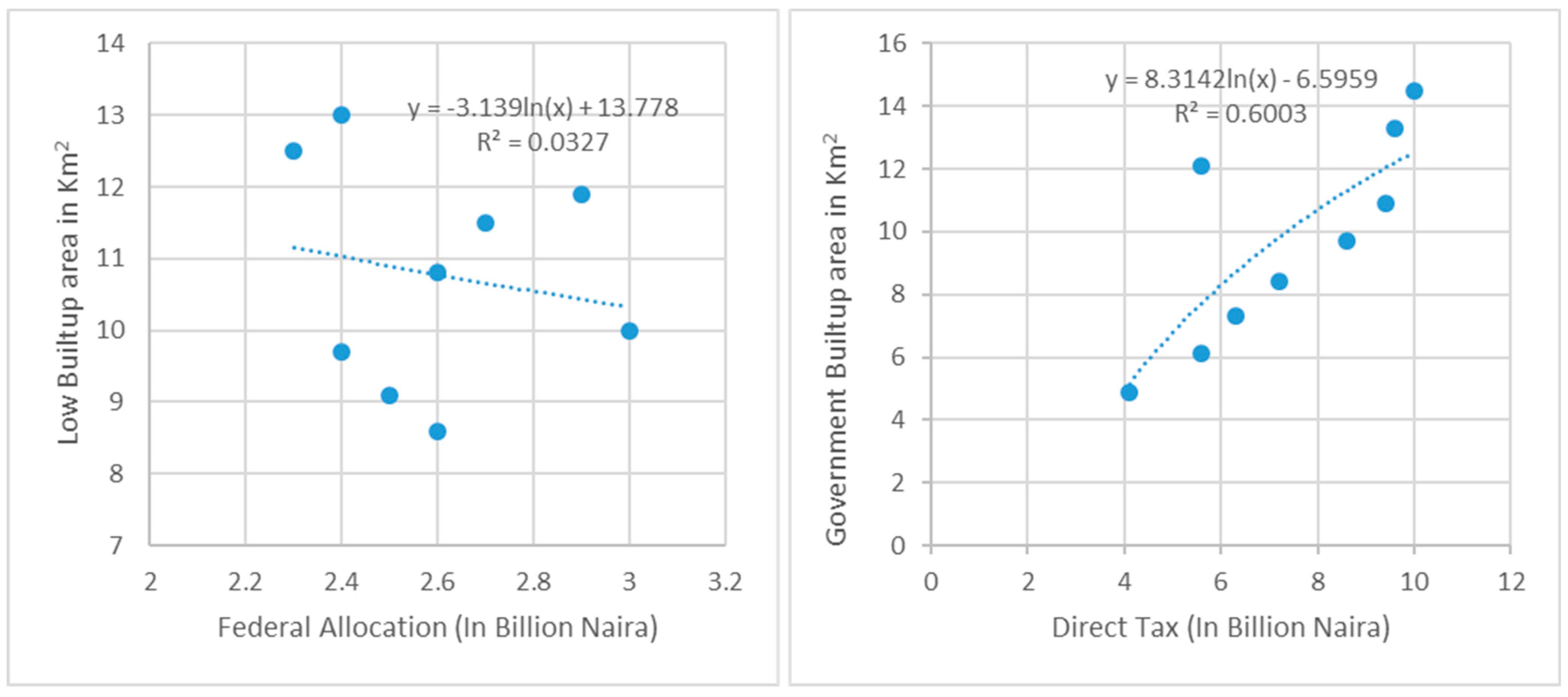
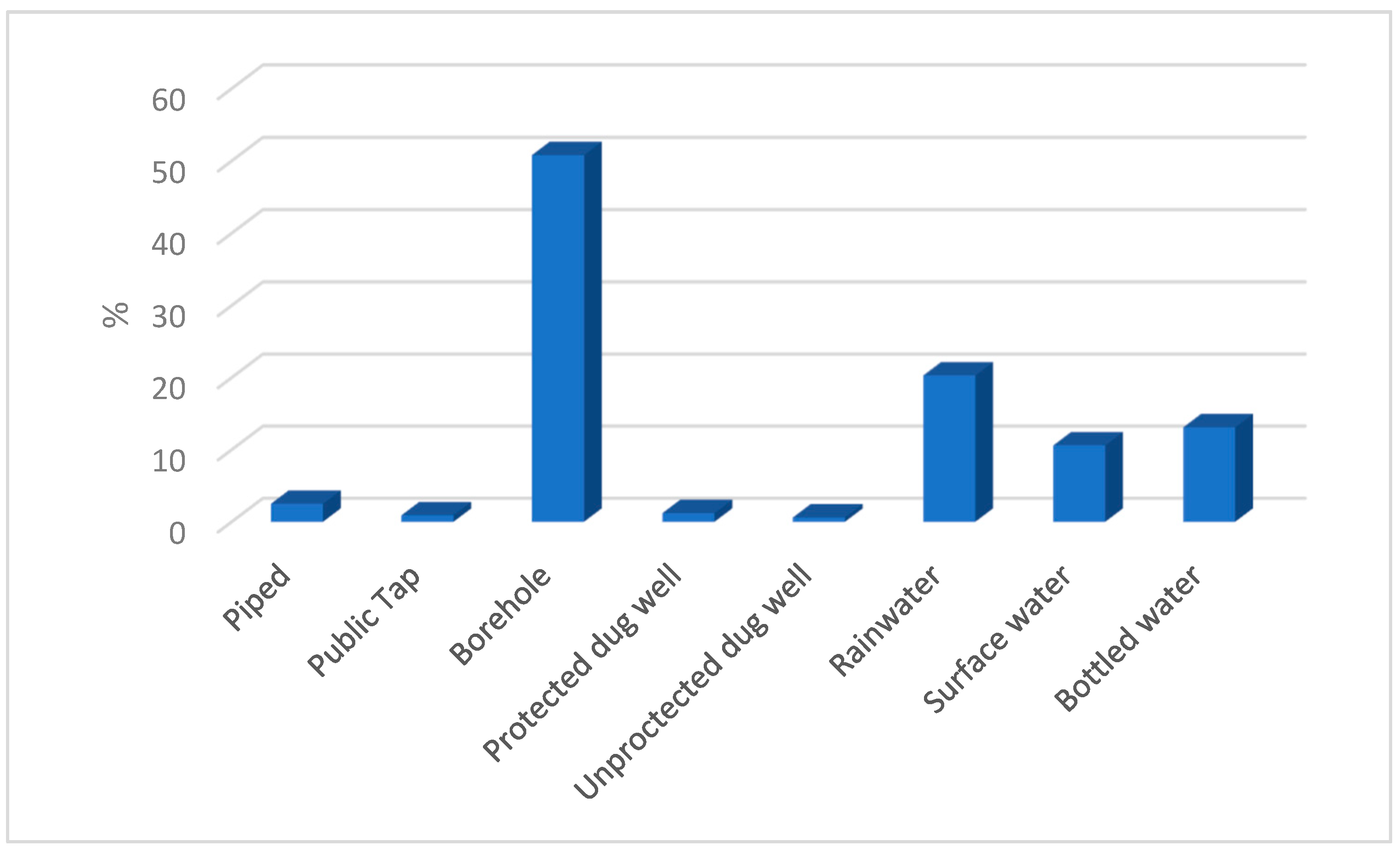
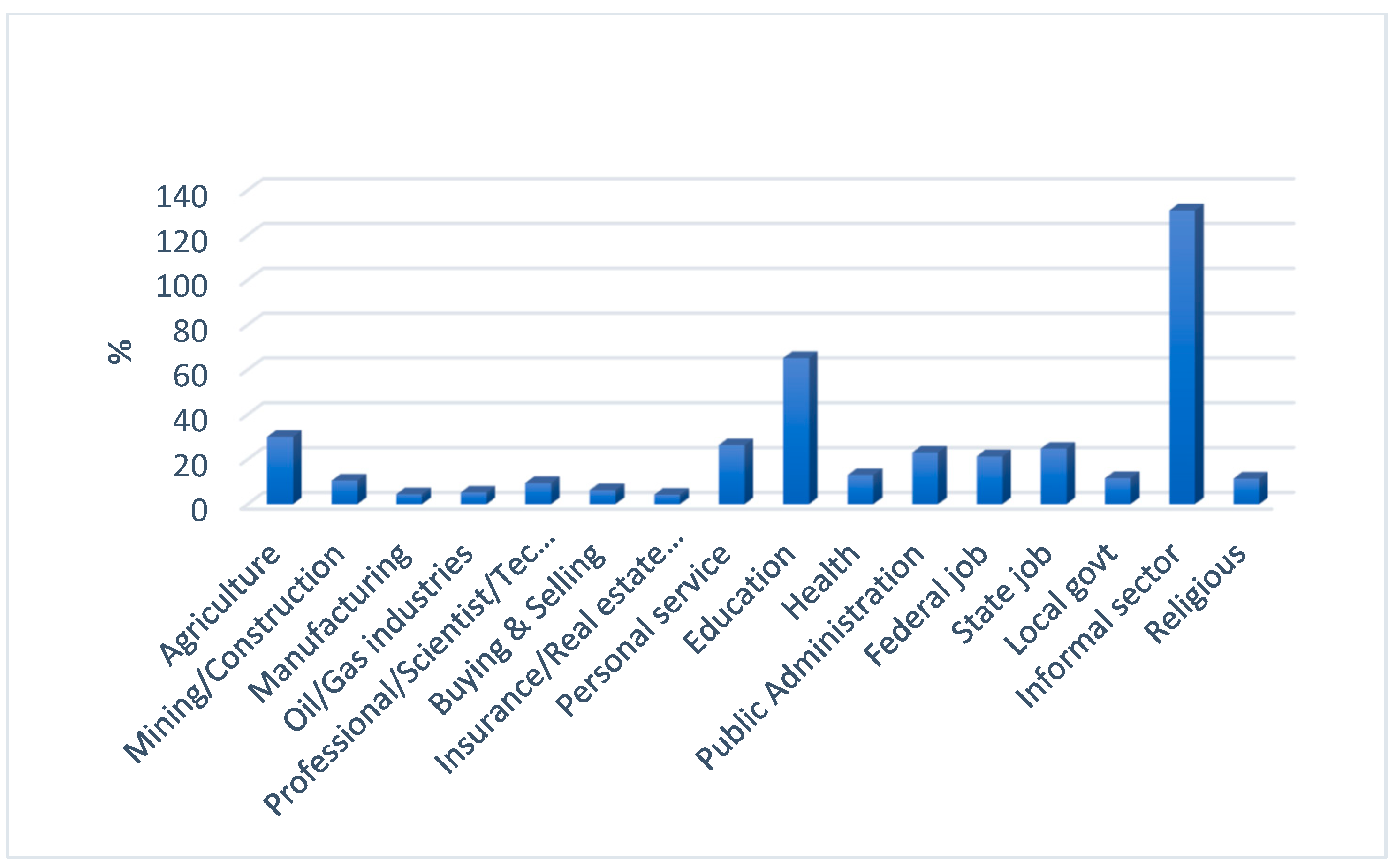
| Independent Variables | Dependable Variables | Description |
|---|---|---|
| Land-use change | Statistical changes that occur in land use over time. | |
| Direct tax | Tax levied directly from individual income or corporate organization by the government. | |
| Indirect tax | Tax levied on the sale of goods by either a manufacturing company or small business. | |
| Investment tax | Tax levied by the government on investors when intending to open a company. This tax depends on the total capital the investor plans to invest. | |
| Federal revenue | An amount paid by the federal government to all the local governments monthly for utilities and projects’ maintenance. |
| Land-Use Type | Description |
|---|---|
| Low-density built-up area | Occupied by either high-income or low-income earners depending on the majority of inhabitants in a neighborhood with a similar type of income. Characterized by high rental fees for businesses and residents, high level of security, a lot of undeveloped land, and near the urban designated area that has most of the social amenities. |
| Medium-density built-up area | Residential area mostly occupied by medium-income earners, near the suburban area and the main road. Affordable rental fees, not too clustered, not so many unsealed streets. |
| High-density built-up area | These are residential areas mostly occupied by low-income earners. Characterized by many informal businesses, clustered houses, cheaper rents, slums, security problems, many unsealed and filthy streets, unstable power supply, and highly polluted. |
| Government built-up area | Characterized by government buildings, offices, new infrastructures, and very few residential buildings owned mostly by old occupants of the area. |
| Vegetation | Low and high vegetation canopy, cropland, football fields, gardens. |
| Direct Tax | Indirect Tax | Investment Tax | Federal Allocation |
|---|---|---|---|
| 0.03 ** | −0.56 ** | 0.71 ** | 0.62 ** |
| Area (km2) 2010 | Area (km2) 2018 | Land-Use % | Land-use Change (%) 2010–2018 | Annual Change (km2/yr.) | |
|---|---|---|---|---|---|
| Low-density built-up | 8.6 | 13.0 | 6.0 | 4.4 | 0.5 |
| Medium-density built-up | 28.4 | 40.3 | 19 | 11.9 | 1.5 |
| High-density built-up | 1.6 | 2.2 | 3.0 | 0.6 | 0.7 |
| Government built-up | 4.9 | 14.3 | 8.8 | 9.3 | 1.2 |
| Vegetation | 43.5 | 26.7 | 63.8 | −16.8 | −2.1 |
| Class | Low-Density Area | Medium-Density Area | High-Density Area | Government Area | Vegetation | UA |
|---|---|---|---|---|---|---|
| Low-density Built-up | 34,403 | 0 | 5 | 7 | 0 | 88% |
| Medium-density Built-up | 2 | 1,137,207 | 0 | 9 | 0 | 88% |
| High-density Built-up | 0 | 0 | 64,968 | 0 | 0 | 99% |
| Government Built-up | 0 | 14 | 0 | 199,704 | 0 | 86% |
| Vegetation | 0 | 2 | 0 | 0 | 5,035,248 | 97% |
| Class | Low Density Area | Medium Density Area | High Density Area | Government Area | Vegetation | UA |
|---|---|---|---|---|---|---|
| Low Density built-up | 52,261 | 0 | 0 | 9 | 0 | 90% |
| Medium Density built-up | 13 | 1,614,859 | 6 | 0 | 0 | 89% |
| High Density Built-up | 0 | 19 | 89,028 | 4 | 0 | 86% |
| Government Built-up | 0 | 0 | 7 | 573,926 | 0 | 91% |
| Vegetation | 0 | 0 | 0 | 3 | 4,141,456 | 98% |
Publisher’s Note: MDPI stays neutral with regard to jurisdictional claims in published maps and institutional affiliations. |
© 2021 by the authors. Licensee MDPI, Basel, Switzerland. This article is an open access article distributed under the terms and conditions of the Creative Commons Attribution (CC BY) license (https://creativecommons.org/licenses/by/4.0/).
Share and Cite
Essien, E.; Samimi, C. Evaluation of Economic Linkage between Urban Built-Up Areas in a Mid-Sized City of Uyo (Nigeria). Land 2021, 10, 1094. https://doi.org/10.3390/land10101094
Essien E, Samimi C. Evaluation of Economic Linkage between Urban Built-Up Areas in a Mid-Sized City of Uyo (Nigeria). Land. 2021; 10(10):1094. https://doi.org/10.3390/land10101094
Chicago/Turabian StyleEssien, Etido, and Cyrus Samimi. 2021. "Evaluation of Economic Linkage between Urban Built-Up Areas in a Mid-Sized City of Uyo (Nigeria)" Land 10, no. 10: 1094. https://doi.org/10.3390/land10101094
APA StyleEssien, E., & Samimi, C. (2021). Evaluation of Economic Linkage between Urban Built-Up Areas in a Mid-Sized City of Uyo (Nigeria). Land, 10(10), 1094. https://doi.org/10.3390/land10101094






